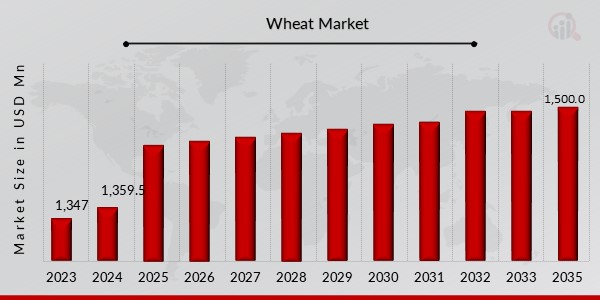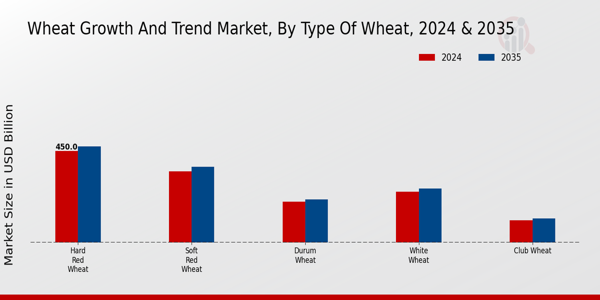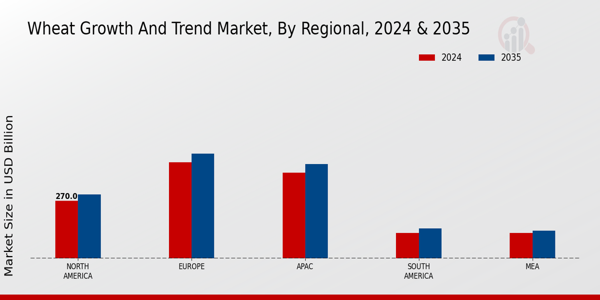Global Wheat Market Overview
Wheat Market Size was estimated at 1,347.44 (USD Billion) in 2023. The Wheat Market is expected to grow from 1,359.56 (USD Billion) in 2024 to 1,500.0 (USD Billion) by 2035. The Wheat Market CAGR (growth rate) is expected to be around 0.9% during the forecast period (2025 - 2035).

Source: Primary Research, Secondary Research, MRFR Database and Analyst Review
Key Wheat Market Trends Highlighted
A number of variables, such as the growing demand for items made from wheat and the world's population, are contributing to the remarkable expansion of the global wheat market.
Wheat is becoming more and more popular as a mainstay in many diets as more people look for wholesome dietary options. Furthermore, greater crop yields due to technological and agricultural practice developments have allowed farmers to effectively fulfill the increased demand.
The amount of wheat produced in various locations is also greatly influenced by weather patterns and climate change. There are a lot of prospects for expansion in the wheat production and supply chain due to this steady demand and better farming practices.
As customers get increasingly picky about where their food comes from, recent trends show a move towards sustainable farming methods. As consumers place a higher priority on environmental and health concerns, organic wheat cultivation and eco-friendly farming practices are becoming more popular.
To further increase productivity, biotechnology advancements are being investigated to create wheat cultivars that are more resistant to pests and climate change.
The trend towards plant-based diets is also contributing to increased consumption of wheat, as it serves as a versatile ingredient in various food products. Investing in infrastructure and distribution networks gives stakeholders an edge in capturing market opportunities.
By tapping into emerging markets and enhancing trade relationships, businesses can meet the demands of rapidly growing populations and changing dietary preferences.
As the global wheat market evolves, stakeholders who adapt to consumer preferences and embrace technological advancements stand to gain a competitive advantage. Overall, the market presents a dynamic landscape characterized by significant potential for growth and innovation in wheat production and distribution.
Wheat Market Drivers
Increasing Global Food Demand
The ever-increasing global population is a significant driver for the Global Wheat Market. The demand for food, particularly staple grains like wheat, is projected to rise significantly. As a primary source of carbohydrates, wheat is integral to various diets around the world. This increasing demand for food translates into a higher requirement for agricultural outputs, thus propelling the growth of the wheat industry.
The Global Wheat Market is positioned to satisfy this hungry market by increasing its production capabilities through innovative farming techniques and improved agronomy practices.
Moreover, as urbanization spreads globally, there is a corresponding shift in dietary preferences towards more wheat-based products such as bread, pasta, and baked goods. This shift represents an opportunity for the industry to cater to rapidly changing consumer preferences, leading to increased sales and market expansion.
In addition, enhanced nutrition awareness is driving consumers towards healthy eating options, further elevating the importance of wheat as a staple food in balanced diets. Therefore, the combination of population growth, urbanization, and changing dietary habits highlights the critical demand factors supporting the Global Wheat Market.
Technological Advancements in Agriculture
Technological advancements in agriculture are rapidly transforming the Global Wheat Market. The introduction of precision farming technologies, genetically modified organisms (GMOs), and advancements in crop management practices have led to enhanced wheat productivity and efficiency.
These innovations allow farmers to monitor crop health, optimize resource use, and improve yield outputs significantly. The enhanced adaptability of wheat varieties to different climatic conditions, pests, and diseases ensures a more resilient supply chain.
As these technologies become more prevalent and accessible, they drive efficiency and profitability within the wheat market, catering to the increasing global demand. Furthermore, as farmers adopt these advanced technologies, the overall production rates are set to increase, ensuring the sustainability of the Global Wheat Market.
Government Support and Subsidies
Government support and subsidies play a pivotal role in the growth of the Global Wheat Market. Many governments worldwide recognize the importance of wheat production for food security and economic stability.
They provide financial assistance, subsidies, and incentives aimed at bolstering wheat production and infrastructure development. Such initiatives encourage farmers to invest in improved seed varieties, fertilizers, and technology.
Governments often engage in research and development programs to enhance wheat productivity and address challenges such as climate change and pest infestations. This support fosters a favorable environment for growth within the wheat industry, thus ensuring a steady supply to meet the increasing consumer demand.
Wheat Market Segment Insights
Wheat Market Type of Wheat Insights
The Global Wheat Market was a vital component of the agricultural sector, characterized by its diverse segmentation into various types of wheat. The market was valued significantly, highlighting the essential role this commodity played in global food security and economic stability.
Among the different types of wheat, Hard Red Wheat held a dominant position with an impressive valuation of 450.0 USD Billion in 2024. This variety was particularly favored for its high protein content and baking qualities, making it a staple ingredient in bread production, thereby sustaining its majority holding in the market.
Soft Red Wheat, valued at 350.0 USD Billion in 2024, represented another critical segment, predominantly used for producing cakes, pastries, and crackers due to its lower protein content compared to Hard Red Wheat. Its significant demand in processed food applications supported a strong market share as consumers continued to favor versatile wheat options for baking and food manufacturing.
Durum Wheat, on the other hand, although slightly less dominant, held an important niche, valued at 200.0 USD Billion in 2024. It was primarily used in pasta production due to its high gluten strength, making it essential in regions where pasta was a dietary staple. The rising global popularity of pasta dishes continues to bolster this segment, securing its relevance in the overall wheat market.
The White Wheat segment, with a valuation of 250.0 USD Billion in 2024, was significant as it catered to health-conscious consumers seeking whole-grain products. Its milder flavor and light color made it appealing for various baked goods, leading to a steady growth trajectory supported by increasing consumer awareness of healthier dietary options.
Lastly, Club Wheat, although the smallest segment, valued at 109.56 USD Billion in 2024, found its importance in specialty markets, particularly for high-quality baking.
Its unique properties and limited availability created a niche demand that supported its existence within the larger market framework. The distinct characteristics of this wheat type make it an important option for artisan bakers and premium product manufacturers.
As the Global Wheat Market continues to evolve, each type of wheat exhibits unique trends, growth drivers, and challenges. While Hard Red Wheat and Soft Red Wheat dominate with their broad applications in everyday food products, Durum's specialization in pasta and White Wheat's health-oriented appeal underlines the complexity and interconnectivity of these segments.
Opportunities for growth are evident in adapting to changing consumer preferences towards healthier and more sustainable food products, which can influence future market dynamics significantly.
Such trends in the Global Wheat Market underline the importance of monitoring ongoing developments in wheat types, as shifts in consumer demand and agricultural practices could reshape the market landscape in the coming years, leading to potential market growth.

Source: Primary Research, Secondary Research, MRFR Database and Analyst Review
Wheat Market Growth Method Insights
The Global Wheat Market has shown significant value, indicating robust activities across various growth methods. The market demonstrates diverse approaches, including Conventional Farming, Organic Farming, Hydroponic Farming, and Sustainable Agriculture, each contributing uniquely to the market dynamics.
Conventional Farming remains a predominant approach due to its widespread adoption and efficiency in wheat production, catering to both domestic and international demands. Organic Farming is gaining momentum as consumers increasingly seek health-conscious choices, driving the demand for organically grown wheat.
Hydroponic Farming presents innovative solutions, leveraging technology for higher yield with limited land usage, appealing in urban settings. Sustainable Agriculture focuses on environmentally-friendly practices, promoting soil health and long-term viability, thus attracting eco-conscious farmers and consumers.
The collective growth of these methods contributes to the overall Global Wheat Market revenue, showcasing a balanced engagement between traditional practices and modern techniques to meet the evolving global demand for wheat.
Understanding the Global Wheat Market segmentation enables stakeholders to strategize effectively in this evolving landscape.
Wheat Market End Use Insights
The Global Wheat Market is experiencing notable developments within the End Use segment, which is crucial in understanding the market dynamics. The segmentation within the End Use category features key areas such as Food Products, Feed Products, and Industrial Uses.
Food Products hold a significant portion of market demand, driven by the constant global necessity for staple food sources. Meanwhile, Feed Products are essential for livestock nutrition, reinforcing their importance as the global population grows and the demand for meat and dairy increases.
Industrial Uses also play a vital role, as wheat is utilized in various non-food applications, contributing to market diversity. With these segments combined, they illustrate the integral nature of wheat in both human and industrial ecosystems, paving the way for consistent market growth in the coming years.
The Global Wheat Market revenue thus reflects robust engagements across these essential categories, adapting to trends and challenges in food security and agricultural innovations.
Wheat Market Application Insights
Flour production is a major application, as it serves as a fundamental ingredient for numerous food products, influencing both quality and quantity. The baking industry experiences consistent demand due to the global popularity of bread and baked goods, making it a significant player in the wheat market. Noodle manufacturing also dominates a large share owing to the growing consumption of noodles in various cuisines worldwide.
Market growth is driven by increasing population and changing dietary preferences, while challenges such as wheat supply stability and climate change may impact production rates. Opportunities lie in innovations for better wheat yield and sustainable practices, which are crucial to meeting the needs of the growing audience.
The Global Wheat Market statistics reveal a multifaceted landscape where each application plays a vital role in shaping the overall market dynamics.
Wheat Market Regional Insights
The Wheat Market showed a diversified landscape across its Regional segmentation, with significant contributions from various areas. In 2024, North America was valued at 270.0 USD Billion, while Europe led with a substantial valuation of 450.0 USD Billion, emphasizing its crucial role in wheat production.
APAC followed closely, valued at 400.0 USD Billion, indicating a strong demand driven by its large population. South America, valued at 120.0 USD Billion, highlighted its emerging importance, although it remained the least dominant region.
The MEA region was valued at 119.56 USD Billion, reflecting its growing market presence. Europe's majority holding in the Wheat Market indicated a strong agricultural infrastructure and export capability.
In contrast, North America's advanced farming techniques and technology adoption supported its significant valuation. APAC's contribution highlighted opportunities for growth due to its increasing consumption patterns, driven by urbanization and dietary changes.
Overall, the segmentation revealed varied dynamics, where regional strengths drove market growth and presented opportunities in the Wheat Market.

Source: Primary Research, Secondary Research, MRFR Database and Analyst Review
Wheat Market Key Players and Competitive Insights:
The Global Wheat Market is characterized by a highly competitive landscape where numerous players leverage technological advancements and innovative practices to enhance wheat production and meet rising global demand. This market is influenced by various factors, including climate change, evolving agricultural techniques, and shifts in consumer preferences for wheat-based products.
Understanding the dynamics of this market requires a comprehensive analysis of the strategies and strengths of key industry participants. Competition is driven not only by the quality of the wheat produced but also by the ability to adapt to market changes and implement sustainable practices that minimize environmental impact.
Within this intricate market environment, insights into the operational efficiency, market penetration strategies, and product differentiation strategies of major companies are essential to grasp the overall trends shaping the future of wheat cultivation and supply.
Land O'Lakes has established a significant presence in the Global Wheat Market through its commitment to high-quality agricultural products and innovation. The company excels in its extensive cooperative network that enables collaboration with growers and farmers, thus fostering a strong supply chain from production to delivery.
Land O'Lakes stands out with its proactive approach toward sustainable farming practices, integrating advanced agricultural technology into its operations which enhances yield initiatives while ensuring eco-friendly methodologies.
The company's investments in research and development further contribute to its competitiveness, allowing it to introduce cutting-edge solutions that address the challenges faced by wheat producers. With a strong focus on community partnerships and education for farmers, Land O'Lakes effectively generates trust and loyalty, positioning itself as a preferred partner in the cultivation and growth of wheat.
Mosaic Company plays a vital role in the Global Wheat Market with its strategic focus on improving crop nutrition and enhancing agricultural productivity. The company's expertise in producing and marketing concentrated potash and phosphate crop nutrients translates into higher wheat yields, enabling farmers to optimize their production.
Mosaic's commitment to sustainable agricultural practices underscores its efforts to minimize environmental impacts while maximizing efficiency in crop production. Through its extensive research initiatives and collaborations with agricultural stakeholders, Mosaic Company provides tailored solutions that meet the specific needs of wheat growers.
The company's comprehensive understanding of fertilizer application techniques, along with its capacity to deliver superior products, reinforces its competitive advantage in the wheat market.
Mosaic's emphasis on innovative practices contributes to its strong market position, driving advancements that respond to both economic pressures and the demand for more resilient agricultural practices.
Key Companies in the Wheat Market Include:
- Land O'Lakes
- Mosaic Company
- Cargill
- Corteva Agriscience
- Nutrien
- Nufarm
- Dow AgroSciences
- Bayer
- BASF
- Archer Daniels Midland
- Olam International
- Louis Dreyfus Company
- Wilmar International
- DuPont
- Syngenta
Wheat Market Developments
Recent developments in the Wheat Market indicate significant fluctuations influenced by climate conditions, trade policies, and geopolitical tensions. Major agribusiness firms like Cargill and Archer Daniels Midland are adapting to shifts in market demand spurred by sustainable practices and innovations in crop production.
The impact of extreme weather has prompted companies like Bayer and Corteva Agriscience to accelerate research and invest in resilient seed varieties. Nutrien and Mosaic Company focus on enhancing fertilizer efficiency and responding to rising commodity prices and supply chain challenges.
Recent mergers and acquisitions, particularly involving companies like Wilmar International and Olam International, signify consistent efforts to expand market reach and optimize supply chains. Additionally, the presence of significant investments from Dow AgroSciences and BASF in precision agriculture technologies underlines the market's commitment to sustainable growth.
The valuation of these companies is on an upward trajectory due to heightened demand for wheat amidst global food security concerns, further influencing strategies to combat supply chain disruptions and enhance productivity. The interplay of these factors continues to shape the dynamics of the Wheat Market.
Wheat Market Segmentation Insights
Wheat Market Type of Wheat Outlook
- Hard Red Wheat
- Soft Red Wheat
- Durum Wheat
- White Wheat
- Club Wheat
Wheat Market Growth Method Outlook
- Conventional Farming
- Organic Farming
- Hydroponic Farming
- Sustainable Agriculture
Wheat Growth and Trend Market End Use Outlook
Food Products
Feed Products
Industrial Uses
Wheat Market Application Outlook
Flour Production
Baking Industry
Noodle Manufacturing
Wheat Market Regional Outlook
-
North America
-
Europe
-
South America
-
Asia Pacific
-
Middle East and Africa
| Attribute/Metric Source: |
Details |
| MARKET SIZE 2023 |
1347.44(USD Billion) |
| MARKET SIZE 2024 |
1359.56(USD Billion) |
| MARKET SIZE 2035 |
1500.0(USD Billion) |
| COMPOUND ANNUAL GROWTH RATE (CAGR) |
0.9% (2025 - 2035) |
| REPORT COVERAGE |
Revenue Forecast, Competitive Landscape, Growth Factors, and Trends |
| BASE YEAR |
2024 |
| MARKET FORECAST PERIOD |
2025 - 2035 |
| HISTORICAL DATA |
2019 - 2024 |
| MARKET FORECAST UNITS |
USD Billion |
| KEY COMPANIES PROFILED |
Land O'Lakes, Mosaic Company, Cargill, Corteva Agriscience, Nutrien, Nufarm, Dow AgroSciences, Bayer, BASF, Archer Daniels Midland, Olam International, Louis Dreyfus Company, Wilmar International, DuPont, Syngenta |
| SEGMENTS COVERED |
Type of Wheat, Growth Method, End Use, Market Application, Regional |
| KEY MARKET OPPORTUNITIES |
Sustainable farming practices adoption, Precision agriculture technology integration, Climate-resilient wheat varieties development, Global demand for healthier products, Enhanced supply chain efficiency |
| KEY MARKET DYNAMICS |
sustainable farming techniques, climate change impacts, increasing global demand, technological advancements in agriculture, government policies and subsidies |
| COUNTRIES COVERED |
North America, Europe, APAC, South America, MEA |
Frequently Asked Questions (FAQ) :
The Global Wheat Market is expected to be valued at 1359.56 USD Billion in 2024.
By 2035, the market size is projected to reach 1500.0 USD Billion.
The expected CAGR for the market from 2025 to 2035 is 0.9%.
In 2024, Europe is expected to hold the largest market share, valued at 450.0 USD Billion.
North America is projected to reach a market valuation of 300.0 USD Billion by 2035.
Hard Red Wheat is projected to have the highest market value at 450.0 USD Billion in 2024.
The market value for Soft Red Wheat in 2024 is estimated at 350.0 USD Billion.
Major players include Land O'Lakes, Mosaic Company, Cargill, and Corteva Agriscience among others.
The APAC region is expected to have a market value of 440.0 USD Billion by 2035.
The projected market size for Durum Wheat is expected to reach 212.5 USD Billion by 2035.

















